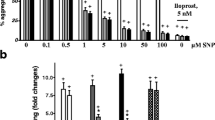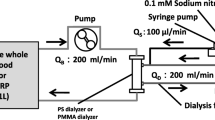Summary
Thrombin-stimulated human platelets adhere to and injure cultured human endothelial cells. We hypothesize that generation of active oxygen species by the stimulated platelets are involved in the injury. To confirm this, catalase [final concentration (8.25 μg/ml)], superoxide dismutase (SOD) (10 μg/ml), ofd-mannitol (9 mg/ml) were added to the cell culture medium before the experiments. Platelet suspension (200.000/μl) and thrombin (4 U/ml) were added and the culture dishes shaken for 15 min at room temperature. In separate experiments the endothelial cells were pretreated with acetylsalicylic acid (0.05, 0.1, or 0.5 mM) to test whether the arachidonic acid metabolism of the endothelial cells is involved in the injury process. In preliminary experiments we were able to confirm that platelets, when stimulated by thrombin, produce chemiluminescence which was suppressed by mannitol but not by catalase or SOD. The degree of injury to cultured endotheial cells by thrombin-stimulated platelets, as measured by release of51Cr from prelabeled endothelial cells, was reduced significantly with the presence of mannitol, but only moderately when catalase or SOD had been added. Morphometric quantification based on scanning electron micrographs of the endothelial cells after exposure to thrombin-stimulated platelets in the presence of catalase or mannitol showed a reduced number of injured cells. Pretreatment of the endothelial cells with acetylsalicylic acid did not cause any significant change in the degree of endothelial cell injury as measured by the51Cr release. It is concluded that active oxygen species, in particular hydroxyl radicals, may be generated during thrombin stimulation of platelets and cause injury to the endothelial cells.
Similar content being viewed by others
References
Allen, R. C.; Loose, L. D. Phagocytic activation of a luminol-dependent chemiluminescence in rabbit alveolar and peritoneal macrophages. Biochem. Biophys. Res. Commun. 69:245–252; 1976.
Boogaerts, M. A.; Van de Broeck, J.; Deckmyn, H., et al. Protective effect of vitamin E on immune triggered, granulocyte mediated endothelial injury. Thromb. Haemostasis 51:89–92; 1984.
Del Maestro, R. The influence of oxygen derived free radicals on in vitro and in vivo model systems. Interactions of superoxide anion radical, hydrogen peroxide and hydroxyl radical. Acta Univ. Ups. 340:1; 1979.
Egan, R. W.; Paxton, J.; Kuehl, F. A., Jr. Mechanism for irreversible self-deactivation of prostaglandin synthetase. J. Biol. Chem. 251:7329–7335; 1976.
Fong, K.-L.; McCay, P. B.; Poyer, J. L., et al. Evidence that peroxidation of lysosomal membranes is initiated by hydroxyl free radicals produced during flavine enzyme activity. J. Biol. Chem. 248:7792–7797; 1973.
Fujimoto, T.; Suzuki, H.; Tanoue, K., et al. Cerebrovascular injuries induced by activation of platelets in vivo. Stroke 16:245–250; 1985.
Goldstein, I. M.; Cerqueira, M.; Lind, S., et al. Evidence that the superoxide-generating system of human leukocytes is associated with the cell surface. J. Clin. Invest. 59:249–254; 1977.
Ham, E. A.; Egan, R. W.; Soderman, D. D., et al. Peroxidase-dependent deactivation of prostacyclin synthetase. J. Biol. Chem. 254:2191–2194; 1979.
Hughes, T.; Tonks, R. S. Intravascular platelet clumping in rabbits. J. Pathol. Bacteriol. 84:379–390; 1962.
Jaffe, E. A.; Weksler, B. B. Recovery of endothelial cell prostacyclin production after inhibition by low doses of aspirin. J. Clin. Invest. 63:532–535; 1979.
Jorgensen, L.; Grothe, A. G.; Larsen, T., et al. Injury to cultured endothelial cells by thrombin-stimulated platelets. Lab. Invest. 54:408–415; 1986.
Jorgensen, L.; Hovig, T.; Rowsell, H. C., et al. Adenosine diphosphate-induced platelet aggregation and vascular injury in swine and rabbits. Am. J. Pathol. 61:161–176; 1970.
Jorgensen, L.; Rowsell, H. C.; Hovig, T., et al. Adenosine diphosphate-induced platelet aggregation and myocardial infarction in swine. Lab. Invest. 17:616–644; 1967.
Kato, T.; Wokalek, H.; Schopf, E., et al. Measurement of chemiluminescence in freshly drawn human blood. I. Role of granulocytes, platelets, and plasma factors in zymosan-induced chemiluminescence. Klin Wsch 59:203–211; 1981.
Krinsky, N. I.; Scoon, K. L.; Hardin, J. C., et al. Source of hydrogen peroxide and of chemiluminescence observed in activated human platelet preparations. Blood 50:597–602; 1977.
Kuehl, F. A., Jr.; Humes, J. L.; Egan, R. W., et al. Role of prostaglandin endoperoxide PGG in inflammatory processes. Nature 265:170–173; 1977.
Kuehl, F. A., Jr.; Humes, J. L.; Torchiana, M. L., et al. Oxygen-centered radicals in inflammatory processes. In: Weissmann, G.; Samuelsson, N.; Paoletti, R., eds. Advances in inflammation research, vol 1. New York: Raven Press; 1979:419–430.
Marcus, A. J.; Weksler, B. B.; Jaffe, E. A., et al. Synthesis of prostacyclin from platelet-derived endoperoxides by cultured human endothelial cells. J. Clin. Invest. 66:979–986; 1980.
Martin, W. J. II. Neutrophils kill pulmonary endothelial cells by a hydrogen-peroxide-dependent pathway: Anin vitro model of neutrophil-mediated lung injury. Am. Rev. Respir. Dis. 130:209–213; 1984.
McCord, J. M.; Fridovich, I. The biology and pathology of oxygen radicals. Ann. Int. Med. 89:122–127; 1978.
Mills, E. L.; Gerrard, J. M.; Filipovich D., et al. The chemiluminescence response of human platelets. J. Clin. Invest. 61:807–814; 1978.
Morrison, A. R.; Winokur, T. S.; Brown, W. A. Inhibition of soybean lipoxygenase by mannitol. Biochem. Biophys. Res. Commun. 108:1757–1762; 1982.
Mustard, J. F.; Perry, D. W.; Ardlie, N. G., et al. Preparation of suspensions of washed platelets from humans. Br. J. Haematol. 22:193–204; 1972.
Sacks, T.; Moldow, C. F.; Craddock, P. R., et al. Oxygen radicals mediate endothelial cell damage by complement-stimulated granulocytes. An in vitro model of immune vascular damage. J. Clin. Invest. 61:1161–1167; 1978.
Shingu, M.; Yosjioka, K.; Nobunaga, M., et al. Human vascular smooth muscle cells and endothelial cells lack catalase activity and are susceptible to hydrogen peroxide. Inflammation 9:309–320; 1985.
Solberg, S.; Larsen, T.; Jorgensen, L. Differences in reactivity of confluent and nonconfluent cultures of human endothelial cells toward thrombin-stimulated platelets or heparinized salt solution. In Vitro 21:612–616; 1985.
Suttorp, N.; Toepfer, W.; Roka, L. Antioxidant defense mechanisms of endothelial cells: glutathione redox cycle versus catalase. Am. J. Physiol. 251:C671-C680; 1986.
Tsan, M.-F.; Danis, E. H.; Del Vecchio, P. J., et al. Enhancement of intracellular glutathione protects endothelial cells against oxidant damage. Biochem. Biophys. Res. Commun. 127:270–276; 1985.
Wörner, P. Arachidonic acid-induced chemiluminescence of human platelets: contribution of prostaglandin and lipoxygenase pathways. Thromb. Haemostasis 46:584–589; 1981.
Author information
Authors and Affiliations
Additional information
This work was supported by the Norwegian Research Council for Science and the Humanities and the Norwegian Council for Cardiovascular Diseases. We express our gratitude for their grants.
Rights and permissions
About this article
Cite this article
Larsen, T., Sørensen, M.B., Olsen, R. et al. Effect of scavengers of active oxygen species and pretreatment with acetyl-salicylic acid on the injury to cultured endothelial cells by thrombin-stimulated platelets. In Vitro Cell Dev Biol 25, 276–282 (1989). https://doi.org/10.1007/BF02628466
Received:
Accepted:
Issue Date:
DOI: https://doi.org/10.1007/BF02628466




